
The Saigon Tax Trade Centre at 135 Nguyễn Huệ
This article was published previously in Saigoneer http://saigoneer.com
In the future, 2014 may be remembered as a watershed year in which a popular urban conservation movement emerged to champion the cause of Hồ Chí Minh City’s fast-disappearing built heritage.
The year 2014 began, just as 2013 had ended, with the destruction of a further batch of Hồ Chí Minh City’s colonial-era heritage buildings to make way for new developments.
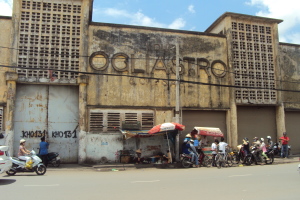
The old Ogliastro warehouse at 132 Bến Vân Đồn in District 4, rebuilt in early 2014
These included 213 Đồng Khởi, 200 Lý Chính Thắng, the last Naval Artillery building at 3A Tôn Đức Thắng, and the old Ogliastro warehouse at 132 Bến Vân Đồn in District 4.
Early in the year the public also learned, through various press articles, the fate of other surviving colonial-era heritage buildings located on so-called “gold land” sites, including 59-61 Lý Tự Trọng, the Catinat Building at 26 Lý Tự Trọng, Bót Catinat at 164 Đồng Khởi, and the Nguyễn Văn Của Imprimerie de l’Union building at 49-57 Nguyễn Du.
However, perhaps what 2014 will be remembered for most is not the continued destruction of old buildings, but rather the growing realisation of local people that old Saigon – once described as the “Pearl of the Orient” – was fast disappearing under the wrecking ball of modernisation. And it was this growing awareness which led, during the course of the year, to the emergence of a community-led urban heritage conservation movement.
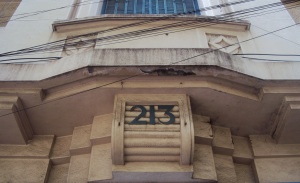
213 Đồng Khởi, demolished in March-June 2014
Public opposition to the fast-paced redevelopment of historic buildings first became apparent in the press coverage which followed the announcement that a new 14-storey City Administration Centre would be built immediately behind the Hồ Chí Minh City People’s Committee building. To make way for the new building, the plan involved the demolition of the art deco office and apartment block at 213 Đồng Khởi (1929) – a building which as recently as 2011 had been earmarked for repair and preservation – along with its neighbour, the former Secrétariat général du gouvernement building (c 1888) at 59-61 Lý Tự Trọng.
Then in March 2014, just as the wreckers began their work on 213 Đồng Khởi, the Vietnamese press gave extensive column space to an alarming report presented to an urban heritage conservation seminar organised by the Hồ Chí Minh Institute of Development Studies (HIDS) and the Hồ Chí Minh City Urban Development Management Support Centre (PADDI). According to this report, of the 377 colonial villas in Districts 1 and 3 which had been catalogued in 1993, more than 56% had been demolished, degraded or significantly altered by 2013.
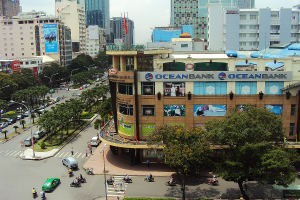
Another view of the Saigon Tax Trade Centre
However, it was the revelation in September 2014 of a long-planned scheme to demolish the Saigon Tax Trade Centre and replace it with a 43-storey tower block which really got the embryonic conservation movement into gear.
Though heavily modified since its glory days as the up-market Grands Magasins Charner (1924) and no longer the city’s most successful department store, the Saigon Tax Trade Centre building enjoyed iconic status and was greatly loved by many local people. Little more than a week after the announcement, a group comprising architects, academics and other concerned citizens had been formed under the leadership of Mr Phùng Anh Tuấn, the Honorary Consul of Finland in Hồ Chí Minh City, to raise concerns about the redevelopment plan and propose alternative solutions. An online petition was subsequently drawn up, requesting the Hồ Chí Minh City People’s Committee to preserve elements of the old building as part of the new development. Shortly before Christmas, responding positively to the recommendations of this group, the People’s Committee announced its agreement to a proposal by the Director of Planning and Architecture that the main lobby of the Tax Trade Centre with its priceless mosaic staircase, along with design features of the building’s exterior façade, should be preserved and incorporated into the new building.
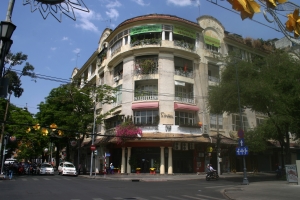
The Catinat Building at 26 Lý Tự Trọng
In December 2014, building upon the momentum of its successful Saigon Tax Trade Centre campaign, the “Tax Team” relaunched itself as the “Saigon Heritage Observatory.” On its Facebook group page, the group declares its stated aims to be: (i) working with a range of partners to encourage and assist in the protection and restoration of historic buildings and streetscapes; (ii) promoting the important role played by the historic environment in economic and social development; (iii) providing a platform for the dissemination of information on best practice in urban conservation management; and (iv) monitoring and raising public awareness about the condition of buildings and streetscapes in danger of damage or destruction.
In 2015, the Saigon Heritage Observatory group plans to launch a unique open data heritage mapping project which will permit members of the public owning GPS-equipped cameras and smartphones to participate in the protection of the city’s heritage by uploading images of old buildings onto a website. These images will automatically be inserted in their correct locations on a Google map of the city, and website moderators will then add relevant details of each building, including date of construction, architect, historical data, architectural/artistic value, current condition and status.
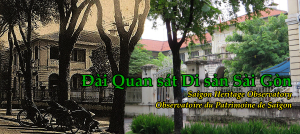
The Saigon Heritage Observatory was set up in December 2014
It is envisaged that the project will become the basis for the development of a comprehensive inventory of colonial-era heritage buildings, something which does not currently exist in Hồ Chí Minh City. In future, the open data heritage mapping project can be used by the Vietnamese authorities and the general public, both as a tool for extending legal protection to selected heritage buildings, and as a means of improving people’s awareness of their cultural significance. It is believed that this will be the first instance of “crowdsourcing” techniques being harnessed in order to protect a city’s endangered built heritage.
Considerable challenges face the conservation lobby here in Hồ Chí Minh City. In the absence of any type of protection, the great majority of the city’s colonial buildings can still be modified or demolished at any time with impunity. While those located on the so-called “gold land” prime sites remain at the greatest risk of destruction, many others may yet be lost before statutory protection measures can be drawn up to save them.
However, the new group believes strongly in the power of community advocacy and remains upbeat about its efforts to protect and preserve what remains of Hồ Chí Minh City’s rich architectural legacy for future generations to enjoy.
Tim Doling is the author of the guidebook Exploring Saigon-Chợ Lớn – Vanishing heritage of Hồ Chí Minh City (Nhà Xuất Bản Thế Giới, Hà Nội, 2019)
A full index of all Tim’s blog articles since November 2013 is now available here.
Join the Facebook group pages Saigon-Chợ Lớn Then & Now to see historic photographs juxtaposed with new ones taken in the same locations, and Đài Quan sát Di sản Sài Gòn – Saigon Heritage Observatory for up-to-date information on conservation issues in Saigon and Chợ Lớn.

